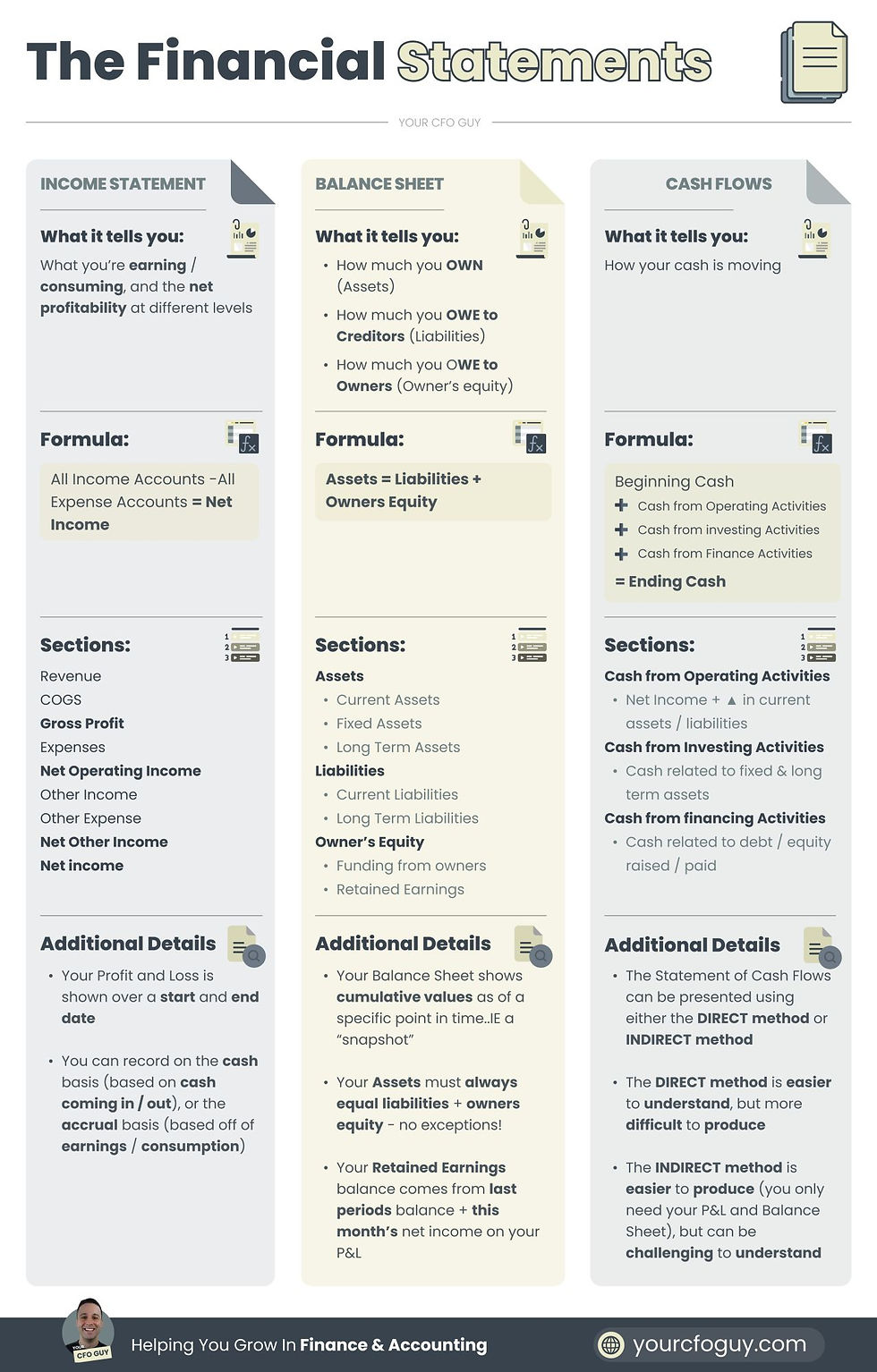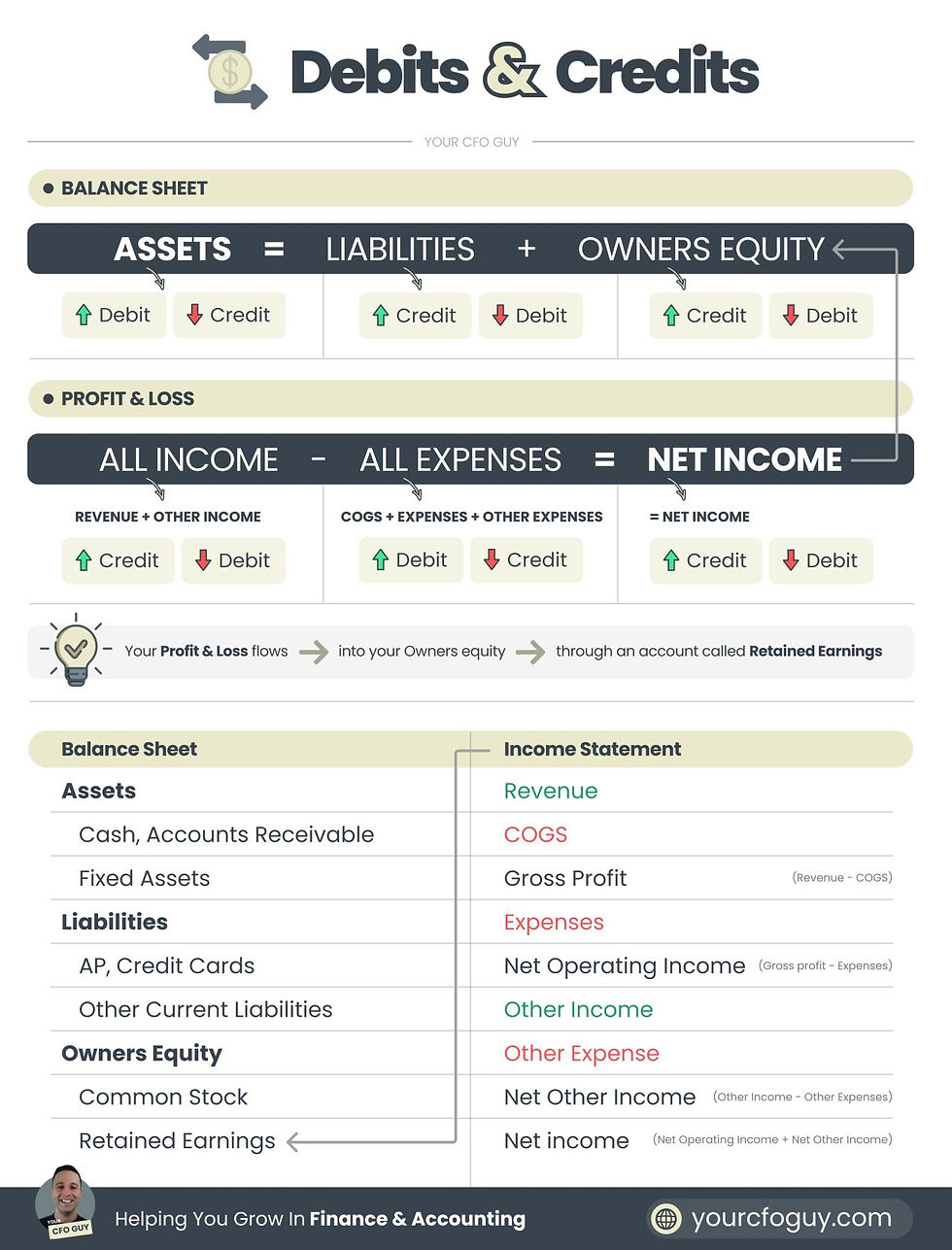Josh Aharonoff
May 4, 2023
Welcome to this week's edition of Legit Numbers - it's a pleasure to have you here!
Each week we cover key topics around Finance & Accounting to help you excel in your career, and understand your businesses finance that much better
What we’ll be covering in this edition:
13 Cash Flows Formulas
PivotTable Profit and Loss
The 3 Financial Statements
Master your Debits & Credits
The 4 Fundamentals to Accounting
Let's dive in...
Cash is King
But before you can wear the crown...you need to know how to measure it
Here are 13 formulas to help you master your Cash Flows:
1️⃣ Operating Cash Flow (OCF):
Formula → Net Income + Depreciation + Amortization + Other Non-Cash Items - Changes in Working Capital
2️⃣ Free Cash Flow (FCF):
Formula → Operating Cash Flow - Capital Expenditures
3️⃣ Cash Conversion Cycle (CCC):
Formula → Days of Inventory Outstanding + Days of Sales Outstanding - Days of Payables Outstanding
4️⃣ Net Cash Flow:
Formula → Operating Cash Flow + Investing Cash Flow + Financing Cash Flow
5️⃣ Discounted Cash Flow (DCF):
Formula → CF1 / (1+r)1 + CF2 / (1+r)2 + ... + CFn / (1+r)n, where CF is cash flow, r is the discount rate, and n is the number of periods.
6️⃣ Present Value:
Formula → CF / (1+r)^t, where CF is cash flow, r is the discount rate, and t is the number of periods.
7️⃣ Future Value:
Formula → CF x (1+r)^t, where CF is cash flow, r is the interest rate, and t is the number of periods.
8️⃣ Payback Period:
Formula → Initial Investment / Annual Cash Flow
9️⃣ Operating Cash Flow to Sales Ratio:
Formula → Operating Cash Flow / Net Sales
🔟 Cash Ratio:
Formula → (Cash + Marketable Securities) / Current Liabilities
1️⃣1️⃣ Cash Burn:
Formula → Cash from Operating Activities + Cash from Investing Activities
1️⃣2️⃣ Unlevered Free Cash Flow:
Formula → EBIT x (1 - Tax Rate) + Depreciation & Amortization - Capital Expenditures - Increase in Net Working Capital
1️⃣3️⃣ Levered Free Cash Flow:
Formula → EBITDA - Taxes - Capital Expenditures - Changes in Net Working Capital - Interest Expense

Creating a Profit and Loss PivotTable has many benefits
1️⃣ Easily extend dates using timeline slicers
When you create a PivotTable, you can add what’s called a timeline slicer
That makes it really easy for you to control the dates that you’re showing with just the click of a button
2️⃣ Expand and collapse fields
PivotTables make is really simple to expand details of any fields that you want to expand
Here I segmented by operating expenses by cost type…
allowing me to see a quick glance of what I’m spending across each category
and then I can expand to see the accounts that make up that cost category / section with the click of a button
3️⃣ Double click to drill into details
With PivotTables, you can easily generate a report showing the details behind any totals by just double clicking on the value
After you double click, a new tab will be created instantly showcasing all of the details behind that value
4️⃣ Set slicers to filter for different sections
Looking to only show a segment of your Profit & Loss?
Perhaps you only want to see results for a specific department
Or perhaps you only want to see your Revenue & COGS
When you create a slicer, updating the report for those values is as simple as a click of a button
5️⃣ PivotCharts are a game changer
PivotCharts put your charts on steroids
It allows you to control the outputs from your chart just as much ease as you would control a PivotTable
So when you update a slicer, or a timeline
The chart automatically updates as well
There are many other benefits of using PivotTables…these are just a few
Get this template by click the image below
These 3 statements are affected by close to every action taken in your Finance & Accounting department
Let's take a deep dive on each:
📄 𝐈𝐍𝐂𝐎𝐌𝐄 𝐒𝐓𝐀𝐓𝐄𝐌𝐄𝐍𝐓 (also known as Profit & Loss)
This represents everything in terms of what your company is EARNING...
as well as what your company is SPENDING
Here are the major sections (and what they mean):
⚫ REVENUE
What is being earned via sales
⚫ COGS
The cost to deliver your product or service
⚫ GROSS PROFIT
Your profitability in carrying out your product or service (Revenue - COGS)
⚫ OPERATING EXPENSES
All other costs that relate to your core business, but aren't necessary to carry out your product or service (IE not COGS)
⚫ NET OPERATING INCOME
Gross Profit less Operating Expenses
⚫ OTHER INCOME
Money earned that is not core to the business (common ones can be interest income, or cash back from credit cards)
⚫ OTHER EXPENSES
Expenses that are incurred that are not core to the business (common ones can be depreciation and interest expense)
⚫ NET OTHER INCOME
Other Income - Other Expenses
⚫ NET INCOME
Net operating income + Net other income
📄 𝐁𝐀𝐋𝐀𝐍𝐂𝐄 𝐒𝐇𝐄𝐄𝐓
Here you can see a snapshot of everything the company OWNS (assets)...
while also understanding what the company OWES to creditors (liabilities)...
and the money put into the business through investments & prior profits (owners equity)
It is separated by 3 sections:
⚫ ASSETS
What the company owns / substantially controls that represents economic value.
Common ones are cash, accounts receivable, and prepaid expenses
⚫ LIABILITIES
What the company owes to creditors. Examples can include credit card balances, accounts payable, and deferred revenue
⚫ EQUITY
This is the net value of the company that the owner's can claim, and is typically comprised of amounts invested, and prior earnings (retained earnings)
📄 𝐒𝐓𝐀𝐓𝐄𝐌𝐄𝐍𝐓 𝐎𝐅 𝐂𝐀𝐒𝐇 𝐅𝐋𝐎𝐖𝐒
This statement shows you all of the details that makes up the movements in your cash balance on the balance sheet.
It is comprised of 3 sections
⚫ CASH FROM OPERATING ACTIVITIES
This section shows all of the cash flows from activities related to operating the business
⚫ CASH FROM INVESTING ACTIVITIES
Here you show the cash movements from long term assets
⚫ CASH FROM FINANCING ACTIVITIES
Here you show the cash from all equity investments and debt injected / paid out from the company
This summary is just a brief overview of these 3 statements

Debits & Credits can be a real challenging concept to grasp when starting off in accounting
They are pretty much a whole new language…and most people think they are too confusing to understand
But they are actually really simple
First..
➡️ What are Debits & Credit?
Debits & Credits are kind of hard to to explain because…well
They aren’t really anything
They are just a way of communicating what is happening to an account in your income statement / balance sheet (IE your general ledger)
They are the way you work with what is famously known as “Double Entry Accounting”
➡️ What is Double Entry Accounting?
This pretty much means that everything financially that happens to a business affects atleast 2 accounts in your general ledger
That’s right…every single financial transaction…
And those 2 “actions” are communicated via debits & credits
➡️ How can I remember when to use a Debit, and when to use a Credit?
OK…so this is where it can get confusing
But it’s actually really simple if you understand this formula
ASSET = LIABILITIES + OWNERS EQUITY
All financial activity affects one or more of these 3 sections of your balance sheet
and when using debits & credits…
The way Assets go up or down…
is the complete OPPPOSITE for how Liabilities + Owners Equity go up or down:
And this is all you need to memorize 👇
Assets —> ⬆️ go UP with DEBITS ⬇️ Go DOWN with CREDITS
Liabilities + Owners Equity —> ⬆️ Go UP with CREDITS ⬇️ Go DOWN with DEBITS
➡️ What about the Profit and Loss?
The key thing to remember is that Your Profit & Loss flows ⏩ into your Owners equity ⏩ through an account called RETAINED EARNINGS
So your Net Income goes UP ⬆️ with Credits
and DOWN ⬇️with Debits
Than means that any P&L account that’s GOOD for your net income (like Revenue)
Will go up by…..?
That’s right - a CREDIT
And things that are BAD for your net income (like COGS / Expenses)
Will go up by…?
Exactly! A DEBIT
What do you think? Was that simple enough for you to understand?

If I had to sum up Accounting in just 4 things, it would easily be these:
1️⃣ Assets = Liabilities + Owners Equity
This one formula pretty much sums up accounting to me…and I imagine most would say the same
It may sound simple, but it is really so deep
Everything your business OWNS (assets)
Was funded by either CREDITORS (liabilities)
Or OWNERS (Equity)
And each of those things have so many examples, and so many things to expand upon
2️⃣ The Financial Statements
These refer to the Profit and Loss, Balance Sheet, and the Statement of Cash Flows
The Profit and Loss tells you how much you’re EARNING
The Balance Sheet shows you What OWN, vs OWE (to creditors & owners)
The Statement of Cash Flows shows you where you’re cash is going
All 3 of these are important…
Though the Profit and Loss + Balance Sheet are usually more popular
Since you can create a Statement of Cash flows using the data from those 2 statements
3️⃣ Debits & Credits
This is pretty much the language that accountants speak
Debits & Credits don’t actually mean anything…
They are just a way of describing whether something is INCREASING, or DECREASING
That means that depending on the type of account…
You can understand what is happening (IE the balance is going up or down), by hearing the words debit or credit
4️⃣ Cash vs Accrual
Cash basis of accounting means you are classifying all money in as income, and all money out as expenses (with some exceptions)…
Accrual basis of accounting means you are classifying income only when it’s EARNED, and classifying expenses only when they are INCURRED…regardless of cash activity
Accrual basis of accounting is much more popular for larger companies, and is required by GAAP

That's a wrap for this week's Legit Numbers!
I hope you found this digest informative and gained some valuable insights into accounting and finance.
As always, I welcome your feedback and suggestions for future topics. If you enjoyed this edition, please consider leaving a testimonial here.
See you next week!

